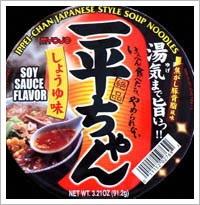By Bethany Lankin
The packaging reminded me of the old movie gag where the protagonist is introduced to a foreign diplomat and her translator. The diplomat prattles on for several minutes in some remote language and her translator finally says “She say, hello.”
I don’t understand Chinese, but I suspect it doesn’t take 41 Asian logograms to communicate the only English words on the package: “Soy Sauce Flavor” and “Ippei-Chan Japanese style soup noodles.”
 Recent translation mishaps during a trip to Spain have made me a more cautious consumer. I asked the waiter to write down what I was eating and discovered stateside that what I thought was some sort of pasta turned out to be “Worms (baby eels) served raw.” That explained why the waiters laughed so much when I ordered a second round.
Recent translation mishaps during a trip to Spain have made me a more cautious consumer. I asked the waiter to write down what I was eating and discovered stateside that what I thought was some sort of pasta turned out to be “Worms (baby eels) served raw.” That explained why the waiters laughed so much when I ordered a second round.
The soup lid’s most prominent message – Long dash, Capital “T” with wings and a tutu, Sloppy drunken five, and Capital “L” holding an ankh symbol with a Jimmy Durante nose – could have meant anything from “Noodles” to “Lark’s vomit” to “Inka Dinka Doo” for all I knew. But the bowl of soup pictured on the lid comforted me with its friendly and familiar good looks. The corn niblets were particularly non-threatening.
This was a Styrofoam bowl style ramen. The raw noodles had been molded into a disk shape and sat on the bottom of the bowl along with three soup packets. The disk was tougher than the usual ramen “brick” and I had to use a fork to chip some away some of the noodles in order to taste them. Excellent! If they had been in a more snack-friendly form I would have eaten them raw. One of the three packets was a liquid soup base. Liquid soup bases are highly regarded in ramen circles by ramen aficionados. This was the first one I had come across and I was keen to taste what all the fuss was about. Yes, there are ramen circles and ramen aficionados.
I added boiling water and waited three minutes. I peeled back the paper cover and smelled soy sauce, seaweed, meat, and something fermented. The broth was a dark caramel color with a layer of golden oil. It was sweet, salty, and rich and I could taste garlic and beef. It was comforting in the same way a good miso soup is comforting. After the first few bites I made a yummy noise loud enough to wake my cat.
The vegetables rehydrated fairly well. The corn, cabbage, and onion were sweet, and I found flakes of fried garlic that were potent and delicious. The bamboo shoots were pleasantly chewy. The cooked noodles were slightly mushy. They tasted better raw.
This soup had more ingredients than any ramen I’ve had so far – a whopping 77. The noodles alone contained 18 ingredients. The esteemed liquid soup base contained salt, three kinds of MSG, spices, a flavor enhancer, and six kinds of fat, including lard.
Lard may be making a comeback. Since hydrogenated trans fats have become the culinary equivalent of running with scissors, manufacturers and chefs have been pressured to stop using them and some have switched to lard. Compared to butter, lard contains less saturated fat and higher levels of monounsaturated, or “good” fat. But before you get out that old pie crust recipe you should know that the lard on the store shelves is hydrogenated. To get any health “benefits” you will have to render the lard from pork fat yourself. While you’re at it, use any leftovers to make tallow soap for all the youngins in the holler.
Unfortunately, the rest of the ingredient list reads like Alfred Nobel’s bouillabaisse recipe: seafood extracts of scallop, bonito, mackerel, sardine, salmon, tuna, and shrimp along with alginic acid, disodium succinate, disodium inosinate, sodium metaphosphate, disodium guanylate, and disodium inosinate.
If you don’t mind the questionable ingredients or higher cost, I recommend Myojo Ippei-Chan Japanese style soup. Then again, I also recommend the raw baby eels.
*
Taste/noodle raw: Delicious, but the round disk form makes snacking difficult.
Taste/noodle cooked: Held their kinky shape but slightly mushy.
Taste/Broth: Rich, salty, meaty.
Odor: That rare, “real food” smell – like something made at home.
Hydrogenated oils: No.
MSG: Yes, yes, a thousand times yes.
Calories per serving: 410
Servings per package: 1
Sodium per serving: 2320mg
Price: $2.39
Packets: 3
Overall Ramen Rating: 8.5/10
*
Previously:
– Ramen Review #1: Tradition Noodle Soup Oriental Style.
– Ramen Review #2: Dr. McDougall’s Baked Not Fried.
Posted on July 26, 2007


